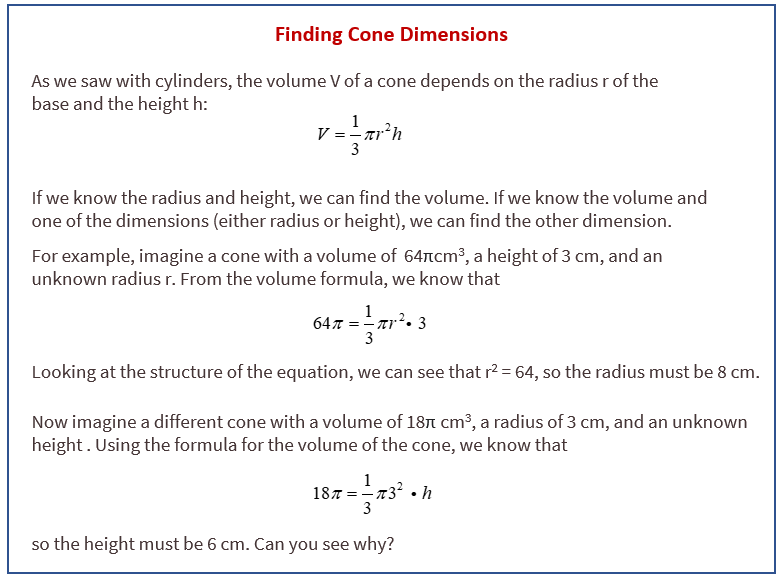Illustrative Mathematics Grade 8, Unit 5, Lesson 16: Finding Cone Dimensions
Learning Targets:
- I can find missing information about a cone if I know its volume and some other information.
Related Pages
Illustrative Math
Grade 8
Lesson 16: Finding Cone Dimensions
Let’s figure out the dimensions of cones.
Illustrative Math Unit 8.5, Lesson 16 (printable worksheets)
Lesson 16 Summary
The following diagram shows how to find missing information about a cone if I know its volume and some other information.

Lesson 16.1 Number Talk: Thirds
For each equation, decide what value, if any, would make it true.
Lesson 16.2 An Unknown Radius
The volume V of a cone with radius r is given by the formula V = 1/3πr2h.
The volume of this cone with height 3 units and radius r is 64π cubic units. This statement is true:
64π = 1/3 πr2 · 3
What does the radius of this cone have to be? Explain how you know.
Lesson 16.3 Cones with Unknown Dimensions
Each row of the table has some information about a particular cone. Complete the table with the missing dimensions.
Are you ready for more?
A frustum is the result of taking a cone and slicing off a smaller cone using a cut parallel to the base.
Find a formula for the volume of a frustum, including deciding which quantities you are going to include in your formula.
-
Show Answer
Volume of frustum = volume of bigger cone - volume of smaller cone.
Quantities needed are the radius and height of the bigger cone and the radius and height of the smaller cone.
Popcorn Deals
A movie theater offers two containers: Which container is the better value? Use 3.14 as an approximation for π.
Lesson 16 Practice Problems
- The volume of this cylinder is 175π cubic units.
What is the volume of a cone that has the same base area and the same height? - A cone has volume 12π cubic inches. Its height is 4 inches. What is its radius?
- A cone has volume 3π.
a. If the cone’s radius is 1, what is its height?
b. If the cone’s radius is 2, what is its height?
c. If the cone’s radius is 5, what is its height?
d. If the cone’s radius is 1/2, what is its height?
e. If the cone’s radius in r, then what is the height? - Three people are playing near the water. Person A stands on the dock. Person B starts at the top of a pole and ziplines into the water. Person C climbs out of the water and up the zipline pole. Match the people to the graphs where the horizontal axis represents time in seconds and the vertical axis represents height above the water level in feet.
- A room is 15 feet tall. An architect wants to include a window that is 6 feet tall. The distance between the floor and the bottom of the window is b feet. The distance between the ceiling and the top of the window is a feet. This relationship can be described by the equation
a = 15 - (b + 6)
a. Which variable is independent based on the equation given?
b. If the architect wants b to be 3, what does this mean? What value of a would work with the given value for b?
c. The customer wants the window to have 5 feet of space above it. Is the customer describing a or b? What is the value of the other variable?
The Open Up Resources math curriculum is free to download from the Open Up Resources website and is also available from Illustrative Mathematics.
Try out our new and fun Fraction Concoction Game.
Add and subtract fractions to make exciting fraction concoctions following a recipe. There are four levels of difficulty: Easy, medium, hard and insane. Practice the basics of fraction addition and subtraction or challenge yourself with the insane level.

We welcome your feedback, comments and questions about this site or page. Please submit your feedback or enquiries via our Feedback page.